Introduction and Literature Review
The COVID-19 pandemic caused manifold negative shocks, impacting the worldwide economy, the environment, and most importantly people’s health. As a result of the increasing cases across the globe, the World Health Organization (WHO) announced the COVID-19 virus as a universal health emergency1 early in 2020. To contain the rapid spread of this virus, governments across the world took stringent measures. For instance, public gatherings were limited in some regions, and others banned people from going out at night by setting strict curfews and/or implementing full lockdowns in their cities. Most countries closed their restaurants and only allowed takeout instead of dining in. Cinemas, amusement parks, clubs, and concerts were shut down as well. All in all, people had to start spending more time at home, and whenever possible working (and studying) from home2.
One of the greatest risk factors for disease in today’s world is poor diet and an overall nutritional deficiency3. It is important to maintain a healthy nutritional status since it might serve as a safeguard against a virus’s harmful impacts. For instance, obesity seems to increase the risk of severe illness from COVID-194. Moreover, since a dietary nutrient intake affects a person’s immune system, individuals should aim to strengthen their immunity by following healthy dietary practices, together with tailored physical exercises5.
Although older people and those with chronic diseases seem more susceptible to the danger of COVID-19, younger adults and infants are also prone to the harmful effects of this virus6. People who exercise regularly and lead active health styles build a stronger immune system and stand a better chance against this virus7. On this note, universities usually provide facilities for their students that encourage active participation in sports events and other physical activities that help students maintain an active lifestyle. However, since universities have had to move to online delivery during the COVID-19 pandemic, physical participation in activities and sports has been compromised, thus increasing the long-term risks associated with sedentary lifestyles, unless students found other ways of staying active.
The WHO reported that temporarily closing several factories due to COVID-19 greatly limited the supply of nutritional food such as fruits and vegetables and thus burdened those who were health-conscious. This is a serious issue since good nutrition is critical for one’s health and overall well-being, especially during a time when people’s immune systems are more at risk8. Moreover, restricted access to nutritional food that contains beneficial vitamins appears to impact not only people’s physical health, but their mental health as well. This is because during quarantine people tend to get bored and anxious, and this in turn might lead them to consume more food and food of lower nutritional value8. Concerningly, a poor nutritional lifestyle leads to adverse physical and mental health effects such as stress, weight gain, increased sugar levels, and an overall weakened immune system9 . Therefore, it appears important to undertake a healthier dietary lifestyle, especially during this pandemic10.
There appears to be limited research in terms of how younger groups of the population react during a pandemic in terms of food intake and physical activity. This research examines how the COVID-19 pandemic impacted university students’ dietary practices and overall lifestyle. The sampling approach followed is non-probabilistic, yet results provide an initial glimpse into how—and whether—students’ lives changed during the pandemic. It aims to see whether University students in the UAE have been affected by COVID-19 when it comes to their dietary practices and lifestyle.
Dietary Practices and Exercise
Our immune systems seem to be affected by our dietary practices11, 12, 13. Various factors such as gender, age, and health status play important roles in affecting nutritional status. Moreover, several dietary components are factors of a person’s microbial gut structure and consequently shape the body’s immune responses. Research shows that the only maintainable method to survive during the rapid spread of COVID-19 is to strengthen the immune system. Abundant consumption of vitamins A, B, C, and E, along with iron and zinc, are crucial in sustaining a healthy and strong immune system. The WHO advises consuming foods that contain such vitamins, including fruits, vegetables, nuts, and whole grains 8. However, the COVID-19 virus itself made it challenging for people to start or maintain a healthy lifestyle due to the restrictions that were placed by governments which reduced access to healthy food and exercise
Research has shown that nutritional status plays a significant role in the outcome of COVID-19 severity14. Certain dietary patterns such as reducing sugar and salt intakes, cutting fatty foods, increasing fiber intakes and others are beneficial to fight noncommunicable disease that affect the patient outcome when contracting COVID-1915. Overall, host nutritional status has been proven to be a main factor in the outcome of an array of infectious diseases16. Although lockdowns, self-isolation, and social distancing are essential in reducing the spread of the virus and flattening the contagion curve, such measures might have, at the same time, adverse effects on people’s lives. These effects not only include dietary practices, but also physical activities, sleeping patterns, psychological and emotional well-being, and overall lifestyles as well. Being inactive or sedentary might impact a person’s physical and mental health, which can consequently lead to a higher risk of obesity and other morbidity factors8. Self-isolation can also lead to increased anxiety, perceived stress, and depression17. Anxiety and stress can also alter a person’s eating habits and lead to unhealthier approaches to eating such as consuming less food, stress eating or overeating, or even eating food with little to no nutritional value18. Furthermore, during confinement it was difficult to shop for fresh food and at some instances certain places suffered from shortages in certain fresh products because of the disruption in food chains worldwide19. Some studies revealed that the pandemic has improved the dietary trends especially amongst adolescents19, 20.
Nutrition is an essential requirement for a human to live and lead a healthy life. A healthy diet is key in building a strong immune system which can help combat and prevent the harmful effects of viruses19. People’s eating patterns are generally influenced by physiological, psychological, and sociological factors18. Since the COVID-19 pandemic had tremendously impacted people’s eating patterns and behaviors, the American Centers for Disease Control and Prevention and WHO, in addition to many healthcare professionals and dieticians, have proposed nutritional recommendations and the types of food that people should consume during this pandemic in order to strengthen their immune systems and fight against this virus4,10. Therefore, besides following vaccination administration protocols which been advocated as a crucial mechanism to secure immunity against viral infections and COVID-19 was no different. Several findings support that widespread use of vaccination provided a safe environment and a decrease in the number of COVID-19 cases21, 22, 23. Assessing efficacy, suitability of vaccines needs to consider several factors that are beyond the scope of this paper, but it is worth mentioning that several peer-reviewed papers have addressed and supported the efficacy of vaccines against COVID-19 it is important for people to consume healthy food and follow proper dietary practices in order to ensure a strong immune system that can help withstand the harmful effects of the COVID-19 virus. Remarkably, this paper was conducted at a time when a COVID-19 vaccine was not readily available albeit announcements of early successful trials were becoming available.
University students tend to lack sufficient nutritional value and healthy diets due to several factors: lack of money, lack of time, or misinformation on what healthy dietary practices are. This study therefore examined how the COVID-19 pandemic has changed the dietary practices and lifestyles of students in the UAE and whether change has been generally positive or negative. Research so far has mostly focused on the general population, highlighting that the pandemic has made it in some instances more difficult to obtain high quality food and a variety of food20. A greater intake of saturated fat24 and a heightened risk of eating disorders25 have also been observed during the pandemic. Although those studies explored the change in dietary practices of people during the COVID-19 pandemic, a small amount addressed it within the context of university students between 2020-2021. Deschasaux et. Al (2020) reported that both unfavorable and favorable nutritional trends amongst people was observed at the same time26. This was linked to sociodemographic and economic positions, anxiety, professional status, and the original diet before the pandemic.
Thus, this study aims to bridge this gap and uncover trends in university students’ diet and lifestyle behaviors, information that may then be used by health practitioners all around the world to improve the advice, support, and care given to university students and perhaps others living in the COVID-19 pandemic.
Materials and Methods
An online cross-sectional survey was prepared to gather information on how the COVID-19 pandemic impacted university students’ dietary practices. The survey was distributed online early October 2020 to 475 university students with a target age between 17 and 35 years old who were studying in five universities in the UAE. Respondents were recruited through non-probabilistic snowball sampling. The survey included 15 questions to identify the respondents’ eating habits and patterns, and their lifestyles during the COVID-19 pandemic. The questions consisted of multiple-choice questions, with some questions allowing more than one answer. Additionally, two questions were included to record gender and age group. The details of the questions are presented below.
Table 1: List of questions and options presented in the survey.
| List of questions and options presented in the survey | |
| Questions | Options |
| 1. Gender? | Male, Female |
| 2. Age group? | Less than 17, 17 to 20, 21-25, 26-30, 31 and above |
| 3.Prior to COVID-19, what were your most common eating habits? * | Cooking at home, dining out, take-outs, Other |
| 4. Since Covid-19 pandemic, have you changed your eating habits? | Yes, No |
| 5. Select the reasons below for your preferences change? | Financial concerns, Health and safety concerns, Personal Concerns, Other |
| 6. Since the reopening of restaurants/cafes back in June, on average, how often per month do you go out to dine in? | 0-2 times a month, 3-5 times a month, 6-10 times a month, 10 or more times a month |
| 7. Since the start of Covid-19 pandemic, which of the following practices have you changed regarding take-out? | Increased the number of take-out, No change, reduced the number of take-out, Removed the food from the bags and threw the boxes out |
| 8. Did you start adding more fruits and vegetables to your diet during Covid-19 pandemic? | Yes, consuming more fruits and vegetables; No change, I included fruits and vegetables in my daily diet prior to the pandemic; No, consuming less fruit and vegetables |
| 9. Have you changed the number of daily meals intake during this pandemic? | Yes, No |
| 10. If yes, how many daily meals intake per day? | Twice, 3 times, four times, 5 times or more |
| 11. Have you started exercising during the Covid-19 pandemic? | Yes, No, I was already exercising before the pandemic |
| 12. How much did you gain or lose since the Covid-19 pandemic? | Gained 1 – 5 KG, Gained 5-10 KG, Gained 10 KG or more, No change, Lost 1-5 KG, Lost 5-10 KG, Lost 10 KG or more |
| 13. If you lost weight, was it because of? * | Eating less, Following a dietary plan, Stress, Exercise, Other, Not applicable |
| 14. If you gained weight was it because of? * | Comfort food, exercising less, stress, other, Not applicable |
| 15. What changes did the Covid-19 pandemic have on your daily routine? * | Better diet, More exercise, Staying at home mostly, other |
| *Multiple answers | |
The survey was pre-tested for clarity and comprehension with a set of 10 students and no particular issues were detected. We ensured the survey would be short to minimize the risk of respondents becoming detached and losing attention. To this end, we also prioritized the questions to include in line with the research goals. This means that certain socio-demographic information is not available, such as whether the students are undergraduate or graduates, or in which University they are enrolled in. Overall, this study presents data from a non-probabilistic convenience sample whereby inference from the broader population should not be conducted. These are preliminary results. In terms of effects that appear significant, or not, these are displayed as part of the ordered logit regression in Table 2. The software that was used to run the regression model is STATA.
The cross-sectional survey questionnaire was distributed by means of social media. The survey was scripted using Google Forms and was kept live for two months: October and November 2020. Prior to the starting of the survey, respondents were provided with an information page that thoroughly explained the aim of the survey and included a consent form that allowed respondents to exit the survey at any time.
Results
Descriptive statistics
The sample consists of 210 (44%) men and 265 (56%) women. Of the 475 total respondents, 200 were between the ages of 17 and 20, 163 were between the ages of 21 and 25, 52 were between the ages of 26 and 30, and 60 were 31 or more years old. A total of 319 (67%) students said they changed their eating habits during the COVID-19 pandemic, whereas 156 (33%) did not change their eating habits at all. The majority, 73% of the students said that one of the main reasons behind changing their eating habits during COVID-19 was related to health concerns.
However, 38% said that the COVID-19 pandemic did not impact their dietary lifestyle as they have had always included fruits and vegetables in their daily diet. In contrast, app 282 (59%) students said that since the COVID-19 pandemic, they started consuming more fruits and vegetables (Figure 1). Only approximately 190 students (40%) claimed that they started incorporating exercise in their daily lives due to the COVID-19 pandemic (Figure 2), but app 127 students (27%) were already exercising prior to COVID-19.
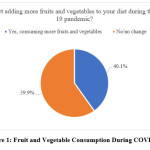 |
Figure 1: Fruit and Vegetable Consumption During COVID-19. |
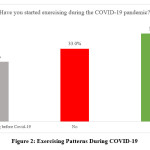 |
Figure 2: Exercising Patterns During COVID-19. |
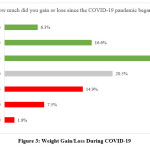 |
Figure 3: Weight Gain/Loss During COVID-19. |
When asked whether they lost or gained weight during the pandemic, over half (55%) said they had lost between 1 and 10+ KG, whereas only 24.3% said they had gained between 1 and 10+ KG (Figure 3). In line with this finding, more than 40% reported they had reduced the number of take-out meals they consumed and had increased the consumption of home-made food (Figure 4).
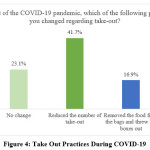 |
Figure 4: Take Out Practices During COVID-19. |
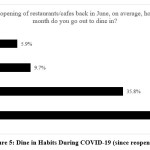 |
Figure 5: Dine in Habits During COVID-19 (since reopening). |
Determinants of stated weight change
Weight change during the pandemic could have many determinants, ranging from changes in diet to changes in exercise, to a combination. In this section we assess the determinants of (stated) weight changes. Results of the ordered logit model are presented in Table 2 below. The coefficients displayed in the Table showcase the change in the ordered log-odds of weight change for a unit increase in the explanatory variable27. It can be noted how age and gender seem to play a significant effect: older and male respondents were more likely to state that they gained weight during the pandemic. A third variable displaying a significant effect is whether respondents started to consume more fruit and vegetables during the pandemic: this seems to be associated with a greater likelihood of having lost weight during the pandemic.
Table 2: Ordered Logit Model, dependent variable: weight change.
| Ordered Logit Model, dependent variable: weight_change | |||
| Explanatory variables | Coef. | Std. Err. | Description |
| Age | 0.159* | 0.084 | Age groups, 4 levels |
| Male | -0.345* | 0.179 | 1 if male, 0 otherwise |
| Exercise_pandemic | 0.083 | 0.171 | 1 if started to exercise during pandemic, 0 otherwise |
| More_fruits_vegetables | -0.627*** | 0.184 | 1 if consumed more fruits and vegetables during pandemic, 0 otherwise |
| Less_takeouts | -0.091 | 0.174 | 1 if reduced the number of take-outs during pandemic, 0 otherwise |
| Restaurant_frequency | -0.143 | 0.102 | Frequency of going to the restaurants, 4 levels |
| Cooking_at_home | -0.24 | 0.174 | 1 if mostly cooking at home, 0 otherwise |
| Eating_habits_change | -0.162 | 0.187 | 1 if eating habits changed during pandemic, 0 otherwise |
| Daily_meals_change | -0.075 | 0.181 | 1 if daily meals changed during pandemic, 0 otherwise |
| ***10% significance level, *1% significance level | |||
Discussion
It seems that majority of students started becoming more health conscious during the pandemic. Previous literature had shown that university students do not have balanced diets, this study shows that during a global pandemic, their behavior might change as they start consuming more nutritious food such as fruits and vegetables. At the same time, while existing literature had suggested that people tend to exercise less and lead sedentary lifestyles because of restrictions and quarantining at home18, this does not seem to be the case among university students in the UAE. Even though the city of Dubai had curfews set every evening for several weeks, this did not stop students from being active and getting their workouts done. When gyms were closed, students managed to find other ways to stay fit. It can be speculated that technological advances have made it easier for people to stay fit within the confinement of their homes including watching online workout videos and following training instructors on fitness activities.
The results displayed in this research confounds with other research conducted in different places. Arumburu et al. (2021) concluded that there are changes in lifestyles of university students during the pandemic28. They have reported that there has been an increased consumption of vegetables and nuts; and physical activity was maintained28. In another study by Renzo et al. (2020), the research reports that the age group of 18-30 have led a healthier dietary lifestyle during COVID-19.29All of the cited research agrees that these changes might be temporary and not long lasting. Yet, it is important to take the initial results to raise nutritional awareness amongst people and be able to make informed decisions in anticipation of any future pandemics.
The nutritional and diet changes during COVID-19 are yet to be seen whether they will last, or it is a short-term change that will end with the end of the pandemic. People may continue in being more aware when it comes to vegetable and fruit intake and depend less on meat intake which can have a benefit for humans and planetary health. All previous research on global pandemics have suggested that nutritional diets have had major implications for health even after pandemics were controlled, so it would be wrong to assume that effects associated with COVId-19 are of any difference.
This research has several important limitations. First, while respondents were asked to disclose their gender, this study did not distinguish between males and females’ dietary preferences and lifestyles. Moreover, the study did not differentiate the responses of different age groups, although such differentiation could have offered useful implications for healthcare practitioners as well. There was not a discussion or any information whether the participants were of a healthy weight or had any other health concerns prior answering the survey. An additional limitation of this study consists in the non-probabilistic sampling employed, hence inference to the broader population is not recommended and it is difficult to draw any conclusive remarks.
Conclusion
In conclusion, the COVID-19 pandemic impacted students’ eating patterns, behavior, and their dietary practices. It also impacted their way of living and their overall lifestyles. Since fending of a virus depends on one’s immunity, WHO and numerous organizations strongly suggested that people should follow a balanced diet and be more active in their daily lives. The results of this study show that students started paying more attention to their diets because of this pandemic, and that they started leading more active lifestyles by exercising more frequently to stay fit and healthy. The outcomes of this research offer implications for healthcare practitioners worldwide, showing how students’ behavior during the pandemic changed in a positive way, and these findings can help establishing awareness sessions about effect of COVID-19 and healthy lifestyles. Access to healthy food needs to be a priority for governments to reduce susceptibility of COVID-19, in addition to the provision of nutritional education to people. Monitoring and tracking nutritional policies across countries during pandemics is a necessity for informed decision making to mitigate any potential negative effects of pandemics on health and nutrition.
Acknowledgement
The research team would like to thank the individuals who generously shared their time, experience, and replies to the questionnaires.
Conflicts of Interest
The authors declare no conflict of interest.
Funding Sources
This research received no external funding.
References
- Velavan, T. P., & Meyer, C. G. The COVID-19 epidemic. Tropical medicine & international health. 2020. 25(3), 278–280.
CrossRef - BBC (2020) Coronavirus: How the world of work may change forever. Available at: https://www.bbc.com/worklife/article/20201023-coronavirus-how-will-the-pandemic-change-the-way-we-work. Accessed in October 2020
- Hallal P. C., Andersen L. B., Bull F. C., Guthold R., Haskell W., Ekelund U. Lancet Physical Activity Series Working Group. Global physical activity levels: Surveillance progress, pitfalls, and prospects. Lancet. 2012. 380, 247–257.
CrossRef - Centers for Disease Control and Prevention (2020) Obesity, Race/Ethnicity, and COVID-19. Available at: https://www.cdc.gov/obesity/data/obesity-and-COVID-19.html
CrossRef - Khoramipour K., Basereh A., Hekmatikar A. A, Castell L., Ruhee R. T., Suzuki K. Physical activity, and nutrition guidelines to help the fight against COVID-19. Journal of Sports Sciences. 2021. 39(1):101-107
CrossRef - Venkatesan P. The changing demographics of COVID-19. The Lancet Respiratory Medicine. 8(112)
CrossRef - Hoffmann B., Kobel S., Wartha O., Kettner S., Dreyhaupt J., Steinacker J. M. High sedentary time in children is not only due to screen media use: A cross-sectional study. BMC Pediatrics. 2019. 19, 154
CrossRef - WHO (World Health Organization) (2020a) Food and Nutrition during Self-Quarantine: What to Choose and How to Eat Healthy; WHO: Geneva, Switzerland, 2020. Available online: http://www.euro.who.int/en/health-topics/diseaseprevention/nutrition/news/news/2020/3/food- and-nutrition-during-self-quarantine-what-to-choose-andhow-to-eat-healthily. Accessed on 15 October 2020.
CrossRef - Hill J.O., Wyatt H.R., Peters J.C. Energy balance and obesity. Circulation. 2012. 126, 126–132
CrossRef - WHO (World Health Organization) (2020b) Be Active during COVID-19; WHO: Geneva, Switzerland, 2020. Available online:https://www.who.int/news-room/q-a-detail/be-active-during-COVID-19. Accessed on 20 October 2020.
- Kubena K.S., McMurray D.N. Nutrition and the immune system: A review of nutrient-nutrient interactions. Journal of the American Dietetic Association. 1996. 96(11):1156-1164
CrossRef - Solomons N. Modulation of the immune system and the response against pathogens with bovine colostrum concentrates. European Journal of Clinical Nutrition. 2020. 56: S24-S28
CrossRef - Laviano A., Koverech A., Zanetti M. Nutrition support in the time of SARS-CoV-2 (COVID-19). 2020. 74, 110834.
CrossRef - Zabetakis I., Lordan R., Norton C., Tsoupras A. COVID-19: The Inflammation Link and the Role of Nutrition in Potential Mitigation. Nutrients. 2020.12, 1466
CrossRef - Beck M.A., Handy J., Levander O. A. Host nutritional status: The neglected virulence factor. Trends in Microbiology. 2004. 12, 417–423
CrossRef - Naja F, Hamadeh R. Nutrition amid the COVID-19 pandemic: a multi-level framework for action. European Journal of Clinical Nutrition. 2020. 74, 1117–1121
CrossRef - Nkire N., Mrklas K., Hrabok M., Gusnowski A., Vuong W., Surood S., Abba-Aji A., Urichuk L., Cao B., Greenshaw A. J., Agyapong V.I.O. COVID-19 Pandemic: Demographic predictors of self-isolation or self-quarantine and impact of isolation and quarantine on perceived stress, anxiety, and depression. Frontiers in Psychiatry. 2021. 12
CrossRef - Leng G., Adan R. A.H., Belot M., Brunstrom J.M., de Graaf K., Dickson S.L., Hare T., Maier S., Menzies J., Preissl H., Reisch L.A., Rogers P.J., Smeets P.A.M. The determinants of food choice. Proceedings of the Nutrition Society. 2017. 76 (3): 316-27.
CrossRef - Glabska, D.; Guzek, D.; Groele, B.; Gutkowska, K. Fruit and vegetables intake in adolescents and mental health: A systematic review. Państwowego Zakładu Hig.2020, 71, 15–25
- Zemrani, B., Gehri, M., Masserey, E. et al.A hidden side of the COVID-19 pandemic in children: the double burden of undernutrition and overnutrition. Int J Equity Health. 2021. 20,
CrossRef
- Khayyatzadeh S. S. Nutrition and Infection with COVID-19. Journal of Nutrition and Food Security. 2020. 5(2):93–96
CrossRef - Jafri A., Mathe N., Aglago E. K., Konyole S. O., Ouedraogo M., Audain K., Zongo A., Johnson J., Sanou D. Food availability, accessibility, and dietary practices during the COVID-19 pandemic: a multi-country survey. Public Health Nutrition. 2021. 24(7)
CrossRef - Lipsitch M., Dean N. Understanding COVID-19 vaccine efficacy. Science. 2020. 370, 763–765
CrossRef - Viner R. M., Mytton O. T, Bonell C., Melendez-Torres G. J., Ward J., Hudson L., Waddington C., Thomas J., Russel S., van der Klis F., Koirala A., Ladhani S., Panovska-Griffiths J., Davies N. G., Booy R., Eggo R. Susceptibility to SARS-CoV-2 Infection Among Children and Adolescents Compared With Adults: A Systematic Review and Meta-analysis. JAMA Pediatrics. 2021. 175(2):143–156
CrossRef - Corey L., Mascola J. R., Fauci A. F., Collins F. S. A strategic approach to COVID-19 vaccine R&D. Science. 2020. 368, 948–950
CrossRef - Murphy B., Benson T., McCloat A., Mooney E., Elliott C., Dean M., Lavelle F.. Changes in Consumers’ food practices during the COVID-19 lockdown, implications for diet quality and the food system: A cross-continental comparison. Nutrients. 2021. 13(1)
CrossRef - Rodgers R. F., Lombardo C., Cerolini S., Franko D. L., Omori M., Fuller-Tyszkiewicz M., Linardon J., Courtet P., Guillaume S. The impact of the COVID-19 pandemic on eating disorder risk and symptoms. International Journal of Eating Disorders. 2020. 53(7): 1166-1170
CrossRef - Deschasaux-Tanguy M., Druesne-Pecollo N., Esseddik Y., de Edelenyi F.S., Allès B., Andreeva V.A., Baudry J., Charreire H., Deschamps V., Egnell M., Fezeu L.K., Galan P., Julia C., Kesse-Guyot E., Latino-Martel P., Oppert J.M., Péneau S., Verdot C., Hercberg S., Touvier M. Diet and physical activity during the coronavirus disease 2019 (COVID-19) lockdown (March-May 2020): results from the French NutriNet-Santé cohort study. Am J Clin Nutr. 2021. 6;113(4):924-938.
CrossRef - H. Greene, Econometric Analysis, (8th edition), Pearson Prentice Hall 2020.
CrossRef - Imaz-Aramburu, I., Fraile-Bermúdez, A. B., Martín-Gamboa, B. S., Cepeda-Miguel, S., Doncel-García, B., Fernandez-Atutxa, A., Irazusta, A., & Zarrazquin, I. (2021). Influence of the COVID-19 Pandemic on the Lifestyles of Health Sciences University Students in Spain: A Longitudinal Study. Nutrients, 13(6), 1958. https://doi.org/ 10.3390/ nu13061958
CrossRef - Di Renzo, L., Gualtieri, P., Pivari, F. et al. Eating habits and lifestyle changes during COVID-19 lockdown: an Italian survey. J Transl Med 18, 229 (2020). https://doi.org/10.1186/s12967-020-02399-5
CrossRef

This work is licensed under a Creative Commons Attribution 4.0 International License.


